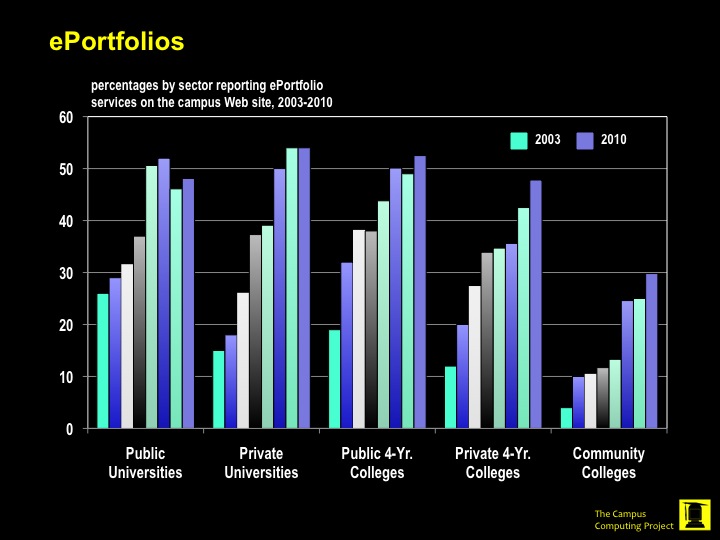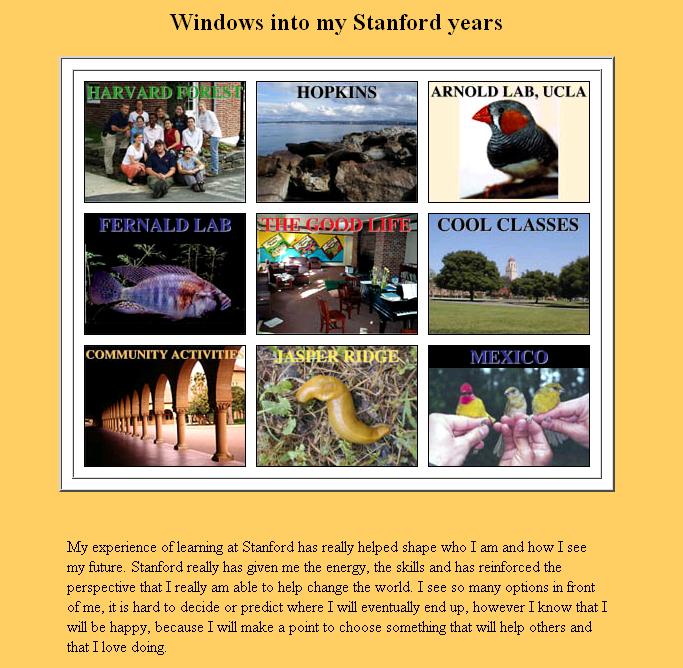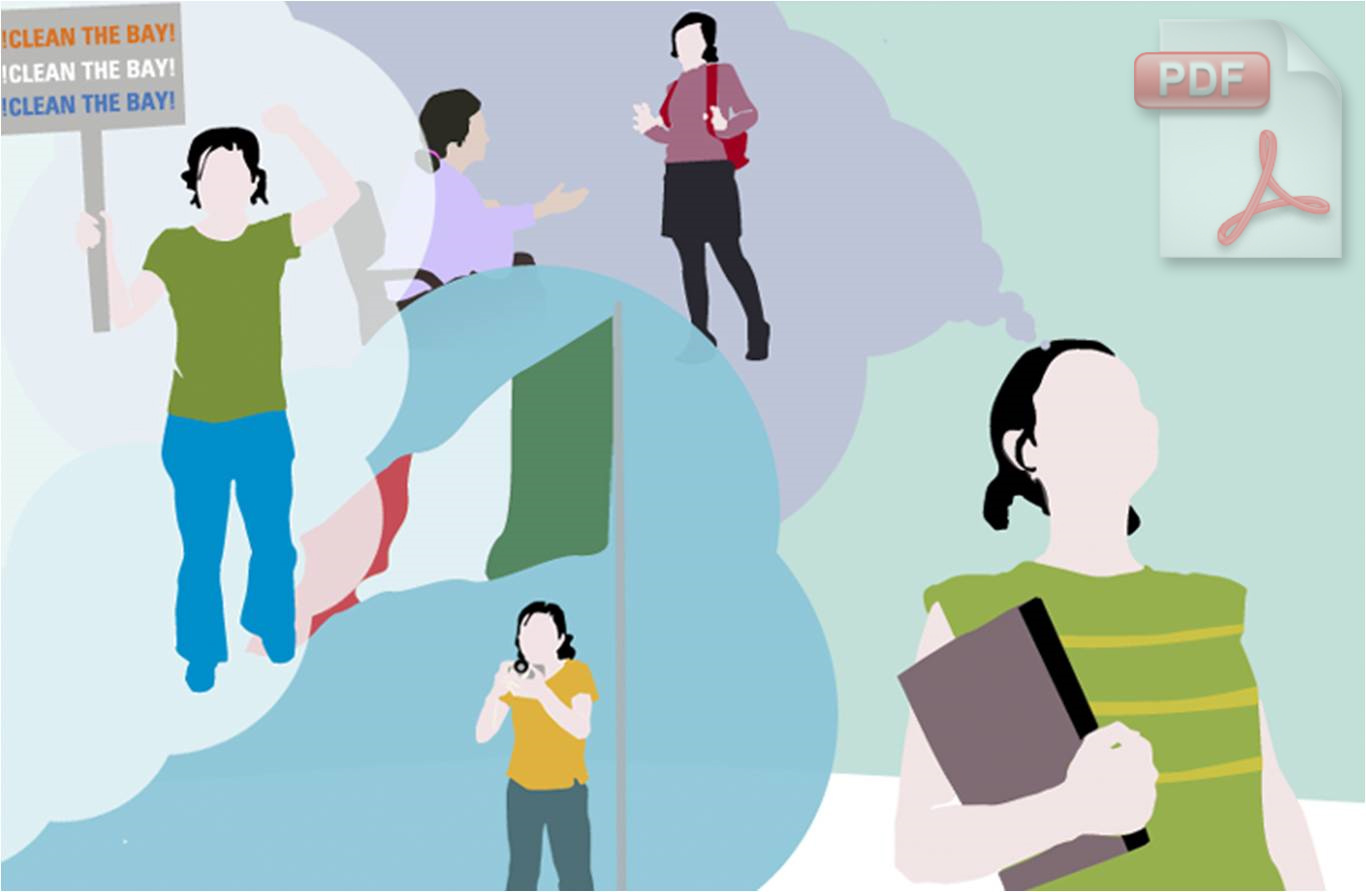Key Takeaways
- E-portfolio efforts at Stanford have focused on capturing and documenting students' learning and engaging in reflection, rationale building, or planning, contributing to a culture of folio thinking.
- In fall 2010, Stanford initiated a pilot introducing e-portfolios to assist with the advising of students in their first two years prior to declaring a major, to learn from students and advisors how e-portfolios and folio thinking can enhance their face-to-face interactions.
- The pilot will explore the possibility that persistence can be improved through the active involvement of others (mentors, alumni, family, peers) in the lives of students as facilitated through the medium of e-portfolios.
"Our country is rearing a group of intelligent young men and women with lots of skills and enthusiasm but little self-knowledge."
— Tim Henderson, The 20-Something Dilemma, Inside Higher Ed, October 21, 2010
Recent years have seen growing interest in electronic learning portfolios (e-portfolios) as a tool to support student learning across higher education in both public and private colleges and universities (Figure 1). The concept of an e-portfolio is multifaceted — it is a technology, a pedagogical approach, and a process, as well as a product. Its purpose can range from tracking development within a program to finding a job or monitoring performance.1

Figure 1. Growth in ePortfolio Services Across Educational Sectors, 2003–20102
Courtesy of The Campus Computing Project, 2010
The e-portfolio efforts at Stanford have been widely distributed across schools and departments on campus. While many of these projects, courses, and programs have not formally used the term "e-portfolio," most share similar themes that are broadly related to capturing and documenting aspects of a student's learning and engaging in some form of reflection, rationale building, or planning, depending on the discipline. These activities contribute to a culture of folio thinking, a pedagogical approach that focuses on designing structured opportunities for students to create e-portfolios and reflect on their learning experiences.3 Instead of prioritizing e-portfolio technology, folio thinking addresses the adoption and integration of e-portfolio praxis in existing contexts as a critical first step toward a successful implementation that can lead to wider scalability and longer-term sustainability of the e-portfolio initiative.4
E-Portfolios and Persistence
While student retention is not a critical challenge at Stanford, our students do represent a broad range of socioeconomic, religious, cultural, and educational backgrounds. Success for all members of the Stanford community is a priority, and we see the combination of e-portfolio technology and folio thinking pedagogy as potentially powerful tools for students to share their unique perspective of their Stanford education, particularly for students of color and students who are the first in their families to attend university. From another view on student retention, we are particularly interested in how e-portfolios might influence persistence in particular majors and professions such as engineering. Recent findings from a national study on the engineering student experience by a Stanford research team led by Professor Sheri Sheppard highlight the importance of offering opportunities that allow students to make connections among coursework, extracurricular involvement, and work experiences.5 More broadly, at the institutional level, how might e-portfolios encourage students toward a lifelong learning career that begins in their freshman year and continues beyond graduation?
An Experiment in Freshman Advising
With these questions in mind, in fall 2010 the Undergraduate Advising and Research (UAR) program within the Office of the Vice Provost for Undergraduate Education and the Office of the Registrar initiated a pilot focused on introducing e-portfolios to assist with the advising of students in their first two years prior to declaring a major. By way of background, all first-year students are assigned a pre-major advisor whose task is to discuss the broad purpose of the intellectual journey they are beginning and how to make the most of their time at Stanford, as opposed to rudimentary curriculum discussions. (Learn more about the Freshman Advising process.)
The goals for the e-portfolio pilot are twofold:
- To explore how e-portfolios can reveal insights into the nature of pre-major advising from the perspective of both students and their advisors.
- To explore how e-portfolios and a culture of folio thinking can enhance the face-to-face interactions students have with their advisors.
The e-portfolios themselves are created and owned by the students; in other words, students have the ability to grant or deny access to their e-portfolios. Unlike a Facebook account or personal website or blog, e-portfolios emphasize students' intellectual identity as it relates to their Stanford education, as opposed to their social or professional identities. Labeled with the Stanford University "brand," the e-portfolio is a structured environment to showcase relevant activities and reflections for advisors, mentors, peers, and others. While our initial emphasis is on advising e-portfolios, students can also create multiple e-portfolios for different audiences. For example, students may create a private e-portfolio to track ideas and interests, a professional portfolio to show a prospective employer, or a research portfolio to document progress made toward completion of an honors thesis.
Given Stanford's residential nature, the advising e-portfolio pilot specifically targets enhancing face-to-face interactions between advisors and students. While the opportunities for mediated communication via e-mail, texting, and web conferencing are many, numerous studies and articles on the Net Generation, multitasking, and digital natives have noted how the dominance and accessibility of media in various forms and formats have affected how students learn and their abilities to communicate in writing and in person, to be contemplative, and to reflect. One theme that we hope to discover in this pilot is how e-portfolios can contribute to a "sense of belonging" to the academic community and whether students feel more engaged and interconnected with the people with whom they live, interact, and learn from. Our pilot will explore the possibility that persistence can be improved through the active involvement of others (mentors, alumni, family, peers) in the lives of students as facilitated through the medium of e-portfolios.
While the focus of this pilot is on student-created e-portfolios, the e-portfolio model and folio thinking approach will be deployed within a community of practice aimed at expanding the opportunities for advisors to interact and exchange suggestions and best practices. Individual advisors also will be able to create their own e-portfolios. Through interviews and logs of advisor-student interactions, we plan to study the nature of the advising process and the factors that influence how students' pre-major interests evolve from when they enter Stanford to when they declare their major. Institutionally, both the UAR and the Office of the Registrar are keenly interested in the outcomes of this pilot and whether further investment in e-portfolios on campus is worthwhile. To address the "lessons learned," a project e-portfolio developed in parallel to inform the evaluation of the success of this work will serve as another resource for participating advisors as well as the UAR.
An Undergraduate Learning Career
The design of the advising e-portfolio pilot builds on prior research on student retention and persistence. Research studies conducted by the ACT on what works in student retention have highlighted the importance of personal future building, described as the "identification and clarification of student goals and directions," as a critical program area to address.6 This finding aligns with the extensive work from George Kuh and his colleagues, whose analyses of the characteristics of 20 participating schools in the Documenting Effective Educational Practice (DEEP) project revealed six features that foster student engagement and persistence, including:
- A "living" mission and "lived" educational philosophy
- Environments adapted for educational enrichment
- An unshakeable focus on student learning
- Clearly marked pathways to student success
- An improvement-oriented ethos
- A shared responsibility for educational quality and student success7
The academic advising pilot also emphasizes shared responsibility and ownership of a "learning career" that is defined as the real-life shape of an individual's learning as it develops inside and outside the classroom, on-campus and off-campus, in face-to-face and virtual environments, and during and after the student's time at Stanford.8 While each individual student's pathway is unique, the milestones that mark the undergraduate learning career are the same, and e-portfolios can play a role supporting the transitions that students will encounter. The story of Chloe, a hypothetical Stanford student, shows how a prototype of an "e-folio" can support her university studies and postgraduate career (see Figure 2). Instead of being a one-time activity never referenced outside academic advising, we envision students sharing their e-portfolios as they transition into their major departments or while meeting their counselors in the Career Development Center. Intrinsic motivation to maintain the learning e-portfolio will become more salient if it is reinforced and reiterated by multiple people and in a variety of contexts over time.
Figure 2. E-Portfolio Uses for Students
Incorporating Prior Learning Experiences
Another pathway to student success facilitated by folio thinking is recognizing students' accomplishments outside the classroom, off campus, and prior to arriving on campus. We know that off-campus experiences gained studying abroad, traveling, and through jobs and internships influence on-campus decisions such as choices of majors and careers. The e-portfolio is one way for the institution to acknowledge and support students who want to draw on and integrate those prior life experiences into their current academic framework. A recent study from the Council for Adult & Experiential Learning found that students, particularly adult learners, who receive college credit for prior learning are not only more likely to graduate than other students who have not received credit but also complete their degrees more quickly. The affordances of the e-portfolio tool to invite students to share those achievements and experiences that have been influential academically, at minimum, establishes a foundation and a starting point for advisors to get to know their advisees and determine how best to guide them.
One example is Stanford sophomore Feross Aboukhadijeh, who became an overnight celebrity after programming YouTube Instant in three hours. While this achievement is documented in his personal website, how does it (as well as the ensuing media frenzy) relate to his computer science major, the courses he plans to take, and his future career plans? (Incidentally, he received a job offer from YouTube, which he accepted.) What role might an advisor or mentor play in helping a student like Feross reflect on and learn from this experience? From the perspective of the institution, how does this experience relate to Stanford, and what level of influence or inspiration did the faculty, fellow students, and entrepreneurial culture on campus have on Feross's education and on his ability to think creatively, communicate his story, and represent who he is as a student, a learner, and a skilled programmer?
Beyond Advising
While introducing the e-portfolio in academic advising is a natural starting point for first-year and transfer students, the success of a broader and longer term e-portfolio implementation depends on the integration of e-portfolios into the Stanford curriculum and in other activities related to milestones of the undergraduate learning career. The Stanford capstone e-portfolio in Figure 3 illustrates the critical experiences identified by a graduating senior who majored in Spanish and biological sciences. Six of the nine experiences she chose to highlight as "panes" in her window emphasize how research — both in the lab and in the field, during the academic year and over the summers — played a critical role in her undergraduate education. Her experiences studying birds in Mexico after freshman year, working in the Arnold Lab at UCLA as a sophomore, and conducting field work in the Harvard Forest after junior year influenced her decision to pursue graduate school versus medical school. Through this e-portfolio and the student's holistic perspective of her Stanford learning career, we can see authentic evidence of impact in ways that current transcripts and records simply cannot capture.

Figure 3. A Capstone E-Portfolio
One potentially noteworthy application of the e-portfolio concept is within the newly initiated Resilience Project, a collaborative effort of the Stanford Center for Teaching and Learning and UAR program, the Career Development Center, and the Office of Judicial Affairs. The Resilience Project invites Stanford professors, alumni, and current students to reflect on some failure or rejection they have experienced in their academic lives — from getting a C- on a paper, to job rejection, to failing a class — and proposes that this rejection, failure, or disappointment, in the context of learning, is as important and valuable as any success or achievement. This process parallels the folio thinking approach where e-portfolios might facilitate the documentation of reflections by students, faculty, and staff on how they have overcome challenging situations. At the same time, the e-portfolios can become a resource for the university community by identifying the kinds of campus experiences and supports that foster the development of resiliency.
In closing, we see e-portfolios and folio thinking as tools that will move students toward the self-understanding and self-knowledge that the author of the opening quotation — a recent graduate from a liberal arts college — felt was missing from his undergraduate education. If we consider the traditional records of an education and what constitutes evidence of learning, there is the academic transcript, which describes the education defined by the institution through the courses taken and grades earned. Another type of record might be the résumé, which acknowledges what students bring to the institution — their cumulative learning to date. The e-portfolio has the potential to encompass both of these views in a format that addresses breadth through formal and informal experiences, is digitally rich, and provides authentic meaning because it represents the education that students have not only received but also how they have interpreted it and made it relevant for themselves.
Additional Resources
The Electronic Portfolio Action and Communication (EPAC) Community of Practice is an international community with free and open membership. It has been a leading resource on electronic portfolios since 2002. See the EPAC Wiki or Twitter page for more information.
Established in 2009, the Association for Authentic, Experiential and Evidence-Based Learning (AAEEBL, pronounced "able"), is a global academic association of educational institutions working toward new designs in learning and assessment, increasing connections among the portfolio community, and building the new learning enterprise.
The Association of American Colleges and Universities' Valid Assessment of Learning in Undergraduate Education (VALUE) Project has developed rubrics for AAC&U's essential learning outcomes that comprise the Liberal Education and America's Promise (LEAP) initiative. These rubrics have been used to assess student work collected using well-planned e-portfolios to inform and guide the effective assessment of general education programs as well as to build self-assessment capabilities in students.
- George Lorenzo and John C. Ittelson, An Overview of E-Portfolios, ELI white paper (Boulder, CO: EDUCAUSE, 2005).
- The Campus Computing Project, "The 2010 National Survey of Information Technology in U.S. Higher Education: Executive Summary," October 2010.
- Helen L. Chen, "Using E-Portfolios to Support Lifelong and Lifewide Learning," Darren Cambridge, Barbara L. Cambridge, and Kathleen Blake Yancey, eds., Electronic Portfolios 2.0: Emergent Research on Implementation and Impact, pp. 29–39 (Sterling, VA: Stylus, 2009).
- Helen L. Chen and Tracy Penny Light, Electronic Portfolios and Student Success: Effectiveness, Efficiency, and Learning (Washington, D.C.: Association of American Colleges & Universities, 2010).
- Sheri Sheppard, Shannon Gilmartin, Helen L. Chen, Krista Donaldson, Gary Lichtenstein, Özgür Eri?, Micah Lande, and George Toye, Exploring the Engineering Student Experience: Findings from the Academic Pathways of People Learning Engineering Survey (APPLES) (Seattle: Center for the Advancement for Engineering Education, 2010).
- ACT, What Works in Student Retention? Fourth National Survey, 2010, p. 1.
- George D. Kuh, Jillian Kinzie, John H. Schuh, Elizabeth J. Whitt, and Associates, Student Success in College: Creating Conditions That Matter (San Francisco: Jossey-Bass, 2005), p. 24.
- Helen L. Chen and Cynthia Mazow, "Electronic Learning Portfolios in Student Affairs," NetResults, June 16, 2002.
© 2010 Helen L. Chen and Thomas C. Black. The text of this EQ article is licensed under the Creative Commons Attribution-Noncommercial-No Derivative Works 3.0 license.

